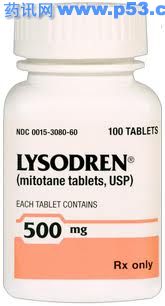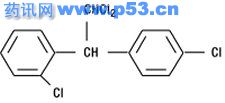|
Mitotane (米托坦) 【原产地英文商品名】LYSODREN 500mg/tab 30tabs/bottle Lysodren®
Lysodren Description Lysodren is a white granular solid composed of clear colorless crystals. It is tasteless and has a slight pleasant aromatic odor. It is soluble in ethanol, isooctane, and carbon tetrachloride. It has a molecular weight of 320.05. Inactive ingredients in Lysodren tablets are: avicel, Polyethylene Glycol 3350, silicon dioxide, and starch. Lysodren is available as 500 mg scored tablets for oral administration. Lysodren - Clinical PharmacologyLysodren can best be described as an adrenal cytotoxic agent, although it can cause adrenal inhibition, apparently without cellular destruction. Its biochemical mechanism of action is unknown. Data are available to suggest that the drug modifies the peripheral metabolism of steroids as well as directly suppressing the adrenal cortex. The administration of Lysodren alters the extra-adrenal metabolism of cortisol in man; leading to a reduction in measurable 17-hydroxy corticosteroids, even though plasma levels of corticosteroids do not fall. The drug apparently causes increased formation of 6-β-hydroxycortisol. Data in adrenal carcinoma patients indicate that about 40% of oral Lysodren is absorbed and approximately 10% of the administered dose is recovered in the urine as a water-soluble metabolite. A variable amount of metabolite (1%-17%) is excreted in the bile and the balance is apparently stored in the tissues. Following discontinuation of Lysodren, the plasma terminal half-life has ranged from 18 to 159 days. In most patients blood levels become undetectable after 6 to 9 weeks. Autopsy data have provided evidence that Lysodren is found in most tissues of the body; however, fat tissues are the primary site of storage. Lysodren is converted to a water-soluble metabolite. No unchanged Lysodren has been found in urine or bile. Indications and Usage for LysodrenLysodren is indicated in the treatment of inoperable adrenal cortical carcinoma of both functional and nonfunctional types. ContraindicationsLysodren (mitotane tablets, USP) should not be given to individuals who have demonstrated a previous hypersensitivity to it. WarningsLysodren should be temporarily discontinued immediately following shock or severe trauma, since adrenal suppression is its prime action. Exogenous steroids should be administered in such circumstances, since the depressed adrenal may not immediately start to secrete steroids. Lysodren should be administered with care to patients with liver disease other than metastatic lesions from the adrenal cortex, since the metabolism of Lysodren may be interfered with and the drug may accumulate. All possible tumor tissues should be surgically removed from large metastatic masses before Lysodren administration is instituted. This is necessary to minimize the possibility of infarction and hemorrhage in the tumor due to a rapid cytotoxic effect of the drug. Long-term continuous administration of high doses of Lysodren may lead to brain damage and impairment of function. Behavioral and neurological assessments should be made at regular intervals when continuous Lysodren treatment exceeds 2 years. A substantial percentage of the patients treated show signs of adrenal insufficiency. It therefore appears necessary to watch for and institute steroid replacement in those patients. However, some investigators have recommended that steroid replacement therapy be administered concomitantly with Lysodren. It has been shown that the metabolism of exogenous steroids is modified and consequently somewhat higher doses than normal replacement therapy may be required. PrecautionsGeneralAdrenal insufficiency may develop in patients treated with Lysodren, and adrenal steroid replacement should be considered for these patients. Since sedation, lethargy, vertigo, and other CNS side effects can occur, ambulatory patients should be cautioned about driving, operating machinery, and other hazardous pursuits requiring mental and physical alertness. Drug InteractionsLysodren has been reported to accelerate the metabolism of warfarin by the mechanism of hepatic microsomal enzyme induction, leading to an increase in dosage requirements for warfarin. Therefore, physicians should closely monitor patients for a change in anticoagulant dosage requirements when administering Lysodren to patients on coumarin-type anticoagulants. In addition, Lysodren should be given with caution to patients receiving other drugs susceptible to the influence of hepatic enzyme induction. Carcinogenesis, Mutagenesis, Impairment of FertilityThe carcinogenic and mutagenic potentials of Lysodren (mitotane tablets, USP) are unknown. However, the mechanism of action of this compound suggests that it probably has less carcinogenic potential than other cytotoxic chemotherapeutic drugs. PregnancyPregnancy Category C Animal reproduction studies have not been conducted with Lysodren. It is also not known whether Lysodren can cause fetal harm when administered to a pregnant woman or can affect reproduction capacity. Lysodren should be given to a pregnant woman only if clearly needed. Nursing MothersIt is not known whether this drug is excreted in human milk. Because many drugs are excreted in human milk and because of the potential for adverse reactions in nursing infants from mitotane, a decision should be made whether to discontinue nursing or to discontinue the drug, taking into account the importance of the drug to the mother. Pediatric UseSafety and effectiveness in pediatric patients have not been established. Geriatric UseClinical studies of Lysodren did not include sufficient numbers of patients aged 65 years and older to determine whether they respond differently than younger patients. Other reported clinical experience has not identified differences in responses between elderly and younger patients. In general, dose selection for an elderly patient should be cautious, usually starting at the low end of the dosing range, reflecting the greater frequency of decreased hepatic, renal, or cardiac function, and of concomitant disease or other drug therapy. Adverse ReactionsA very high percentage of patients treated with Lysodren have shown at least one type of side effect. The main types of adverse reactions consist of the following:
OverdosageNo proven antidotes have been established for Lysodren overdosage. Lysodren Dosage and AdministrationThe recommended treatment schedule is to start the patient at 2 g to 6 g of Lysodren per day in divided doses, either 3 or 4 times a day. Doses are usually increased incrementally to 9 g to 10 g per day. If severe side effects appear, the dose should be reduced until the maximum tolerated dose is achieved. If the patient can tolerate higher doses and improved clinical response appears possible, the dose should be increased until adverse reactions interfere. Experience has shown that the maximum tolerated dose (MTD) will vary from 2 g to 16 g per day, but has usually been 9 g to 10 g per day. The highest doses used in the studies to date were 18 g to 19 g per day. Treatment should be instituted in the hospital until a stable dosage regimen is achieved. Treatment should be continued as long as clinical benefits are observed. Maintenance of clinical status or slowing of growth of metastatic lesions can be considered clinical benefits if they can clearly be shown to have occurred. If no clinical benefits are observed after 3 months at the maximum tolerated dose, the case would generally be considered a clinical failure. However, 10% of the patients who showed a measurable response required more than 3 months at the MTD. Early diagnosis and prompt institution of treatment improve the probability of a positive clinical response. Clinical effectiveness can be shown by reduction in tumor mass; reduction in pain, weakness or anorexia; and reduction of symptoms and signs due to excessive steroid production. A number of patients have been treated intermittently with treatment being restarted when severe symptoms have reappeared. Patients often do not respond after the third or fourth such course. Experience accumulated to date suggests that continuous treatment with the maximum possible dosage of Lysodren is the best approach. Procedures for proper handling and disposal of anticancer drugs should be considered. Several guidelines on this subject have been published.1-4 To minimize the risk of dermal exposure, always wear impervious gloves when handling bottles containing Lysodren tablets. Lysodren tablets should not be crushed. Personnel should avoid exposure to crushed and/or broken tablets. If contact with broken tablets occurs, wash immediately and thoroughly. More information is available in the references listed below. How is Lysodren SuppliedLysodren® (mitotane tablets, USP) NDC 0015-3080-60—500 mg Tablets, bottle of 100 STORAGEStore at 25°C (77°F); excursions permitted to 15°C-30°C (59°F-86°F) [see USP Controlled Room Temperature]. REFERENCES
Manufactured for: 1050972A4 ---------------------------------------------- See How Supplied section for a complete list of available packages of Lysodren. NDC 0015-3080-60 一、药物知识: |
米托坦片|LYSODREN(MITOTANE)简介:
Mitotane (米托坦) 【别名】氯苯二氯乙烷、曼托坦、密妥坦 (米托坦) 解腺瘤片,解腺瘤、Chloditan、Chlonlithane。 商品牌子名:LYSODREN TAB 500MG 药物製造商:Bristol-Myers Squibb 剂型:药片孕妇用 ... 责任编辑:admin |
最新文章更多推荐文章更多热点文章更多 |



